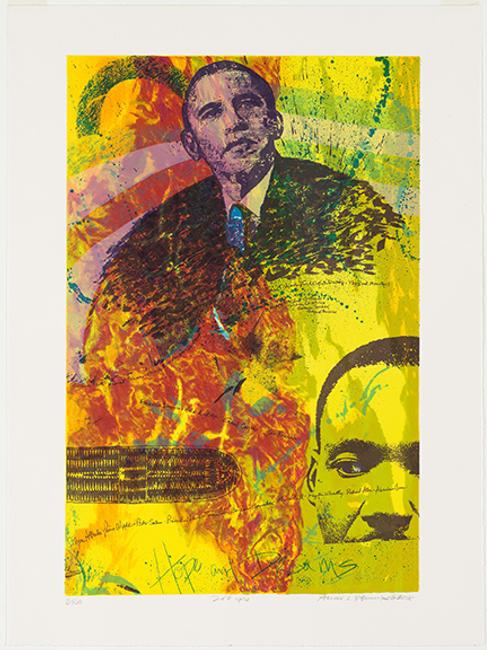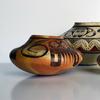Harvard Art Museums Celebrate Brandywine Workshop and Archives with Spring 2022 Exhibition
- CAMBRIDGE, Massachusetts
- /
- February 08, 2022

This spring, the Harvard Art Museums celebrate the 50th anniversary of the Brandywine Workshop and Archives—a Philadelphia-based organization with a history of introducing printmaking to practicing artists and members of the surrounding community—in an exhibition that unites innovative works by nearly 30 artists. Prints from the Brandywine Workshop and Archives: Creative Communities, on display March 4 through July 31, 2022, marks the first presentation of a group of works acquired by the museums in 2018 and honors the creative spirit of the workshop.
Founded in 1972 by artist Allan Edmunds, the Brandywine Workshop and Archives is a nonprofit cultural institution celebrated for its engagement with the local community and educational programming. For five decades, the workshop has offered arts programming in the neighborhoods of Philadelphia and sponsored printmaking residencies for both undiscovered and well-known artists. At Brandywine, collaboration and the exchange of ideas feed a culture of experimentation, in which master printers and artists continually challenge conventions of the creative process and push the technical boundaries of printmaking to produce compelling new works.
The Harvard Art Museums acquired more than 80 works by artists from the Brandywine Workshop in 2018, as part of the workshop’s initiative to place “satellite collections” in university art museums across the United States. The acquisition itself was a cooperative effort between curators and other museum colleagues as well as Harvard University students and professors, who selected works that highlight collaboration and innovation, values at the core of Brandywine’s pioneering approach. The collection spans the history of the workshop, from the early 1970s to today, and includes works by artists who had not yet found representation in the marketplace or museum collections when they arrived at Brandywine—a key constituency of the organization, which seeks to create opportunities for such artists. Harvard’s collection is also distinguished by the decision to include working proofs by some of the artists for future study by students and scholars.

“The Brandywine works in Harvard’s satellite collection have introduced new worldviews and historical perspectives into our collection of contemporary prints,” said Elizabeth M. Rudy, the museums’ Carl A. Weyerhaeuser Curator of Prints and a member of the exhibition curatorial team. “This direct engagement with urgent social, political, and cultural issues will be of interest to students and faculty across the university and to the public as well.”
Prints from the Brandywine Workshop and Archives: Creative Communities is the first major public presentation of the museums’ Brandywine collection, displaying works by nearly 30 artists:
Pedro Abascal, Danny Alvarez, John Biggers, Andrea Chung, Louis Delsarte, Allan Edmunds, Rodney Ewing, Sam Gilliam, Simon Gouverneur, Sedrick Huckaby, Hughie Lee-Smith, Ibrahim Miranda, Tanya Murphy, Kenneth Noland, Odili Donald Odita, Janet Taylor Pickett, Howardena Pindell, Robert Pruitt, Faith Ringgold, Betye Saar, Eduardo Roca Salazar, Juan Sanchez, Clarissa Sligh, Pamela Phatsimo Sunstrum, Hank Willis Thomas, Larry Walker, Stanley Whitney, Deborah Willis, and Murray Zimiles
The exhibition and its associated programming were developed by a creative community on the Harvard campus that sought to emulate the generative, collaborative, and diverse environment fostered by the workshop. Colleagues in two curatorial divisions worked together on the plan: Hannah Chew, Summer 2021 SHARP Research Fellow and 2021–22 Student Assistant; Jessica Ficken, Cunningham Curatorial Assistant for the Collection; Sarah Kianovsky, Curator of the Collection; and Joelle Te Paske, Curatorial Graduate Student Intern, all from the Division of Modern and Contemporary Art; and Elizabeth M. Rudy, Carl A. Weyerhaeuser Curator of Prints; and Natalia Ángeles Vieyra, Maher Curatorial Fellow of American Art, both in the Division of European and American Art.
This core team then invited a variety of perspectives from across campus and beyond to shape the exhibition’s interpretive materials and programming. Each work on display in the gallery is accompanied by a written response from a member of museum staff, a scholar in related fields, a student, or a local artist—and their approaches are as varied as the works described. The exhibition also features a digital companion with students’ creative responses to works in the show. It will be accessible via QR code in the galleries and at hvrd.art/brandywineresponses.

“It’s been so gratifying to see our goals for the interpretive strategy come to life,” said Sarah Kianovsky, of the exhibition curatorial team. “We worked together to identify partners who would be interested in the exhibition, the prints, and their subject matter for future teaching and research, taking it all one step further by inviting them to contribute their perspectives directly on the gallery walls and in exhibition materials. Their responses to the works have been even more rich and varied than we could have hoped for.”
The exhibition will feature a wide range of colorful prints, from individual prints to large multipart installations. An in-gallery video will show archival footage provided by the Brandywine Workshop as well as short interviews with many of the artists. Learn more about the exhibition and the works on display at hvrd.art/brandywine.
Notable works include:
- Nigerian-born Odili Donald Odita’s offset lithograph Cut (2016)—comprised of shards of bright colors that emanate from a diagonal axis—is directly related to the large outdoor mural Our House, which the artist painted on the facade of the Brandywine Workshop building in 2015.
- Me as Me (unframed) (2011), a powerful four-part print by Botswanan artist Pamela Phatsimo Sunstrum that shows two life-size figures—representations of Sunstrum’s alter ego Asme—challenging appropriation and misrepresentation of Black female bodies.
- Wissahickon (1975), a complex abstract screenprint by Sam Gilliam, the first artist to join the workshop’s artist-in-residence series.
- An installation of the 101 intimate portraits that make up Sedrick Huckaby’s series The 99% - Highland Hills (2012–13), which depicts individuals from the artist’s community in Fort Worth, TX. The artist will collaborate with Harvard students on the installation.
- A selection of lithographs from Murray Zimiles’s portfolio Holocaust (1987), showing the horrors of the genocide carried out by the Nazis against Jewish people and other minority groups during World War II.
On view in the museums’ Special Exhibitions Gallery on Level 3, Prints from the Brandywine Workshop and Archives: Creative Communities will run concurrently with another special exhibition, White Shadows: Anneliese Hager and the Camera-less Photograph, the first to focus on the role of women makers in the history of the photogram.
Related Public Programming
The Harvard Art Museums will offer a series of free public programs related to Prints from the Brandywine Workshop and Archives. Some programs will be presented via Zoom, while others may be held in person. For details, updates, and links to register, please see individual listings on our calendar: harvardartmuseums.org/calendar.
On Thursday, March 3, 6–7pm EST, short virtual tours will be offered for the Brandywine exhibition, as well as the exhibitions White Shadows: Anneliese Hager and the Camera-less Photograph and Social Fabrics: Inscribed Textiles from Medieval Egyptian Tombs.
Allan Edmunds, founder of the Brandywine Workshop and Archives, will join exhibition curators Elizabeth Rudy and Sarah Kianovsky for an Art Talk Live, presented via Zoom on Tuesday, March 8, 12:30–1pm EST.
Credits
Support for Prints from the Brandywine Workshop and Archives: Creative Communities is provided by the Alexander S., Robert L., and Bruce A. Beal Exhibition Fund, the Fund for the Contemporary Art Department, and the Robert M. Light Print Department Fund. Related programming is supported by the M. Victor Leventritt Lecture Series Endowment Fund. Modern and contemporary art programs at the Harvard Art Museums are made possible in part by generous support from the Emily Rauh Pulitzer and Joseph Pulitzer, Jr., Fund for Modern and Contemporary Art.
Contact:
Jennifer AubinHarvard Art Museums
617-496-5331
jennifer_aubin@harvard.edu
32 Quincy Street
Cambridge, Massachusetts
617-495-9400
http://www.harvardartmuseums.org
About Harvard Art Museums
The Harvard Art Museums, among the world’s leading art institutions, comprise three museums (the Fogg, Busch-Reisinger, and Arthur M. Sackler Museums) and four research centers (the Straus Center for Conservation and Technical Studies, the Center for the Technical Study of Modern Art, the Harvard Art Museums Archives, and the Archaeological Exploration of Sardis). The Fogg Museum includes Western art from the Middle Ages to the present; the Busch-Reisinger Museum, unique among North American museums, is dedicated to the study of all modes and periods of art from central and northern Europe, with an emphasis on German-speaking countries; and the Arthur M. Sackler Museum is focused on Asian, ancient, and Islamic and later Indian art. Together, the collections include approximately 250,000 objects in all media. The Harvard Art Museums are distinguished by the range and depth of their collections, their groundbreaking exhibitions, and the original research of their staff. Integral to Harvard University and the wider community, the museums and research centers serve as resources for students, scholars, and the public. For more than a century they have been the nation’s premier training ground for museum professionals and are renowned for their seminal role in developing the discipline of art history in the United States. The Harvard Art Museums’ recent renovation and expansion builds on the legacies of the three museums and unites their remarkable collections under one roof for the first time. Renzo Piano Building Workshop’s responsive design preserved the Fogg Museum’s landmark 1927 facility, while transforming the space to accommodate 21st-century needs. Following a six-year building project, the museums now feature 40 percent more gallery space, an expanded Art Study Center, conservation labs, and classrooms, and a striking new glass roof that bridges the facility’s historic and contemporary architecture. The new Harvard Art Museums’ building is more functional, accessible, spacious, and above all, more transparent. The three constituent museums retain their distinct identities in this new facility, yet their close proximity provides exciting opportunities to experience works of art in a broader context. harvardartmuseums.org







_(Medium)100x100_c.jpg)



_He_Lay_100x100_c.jpg)




